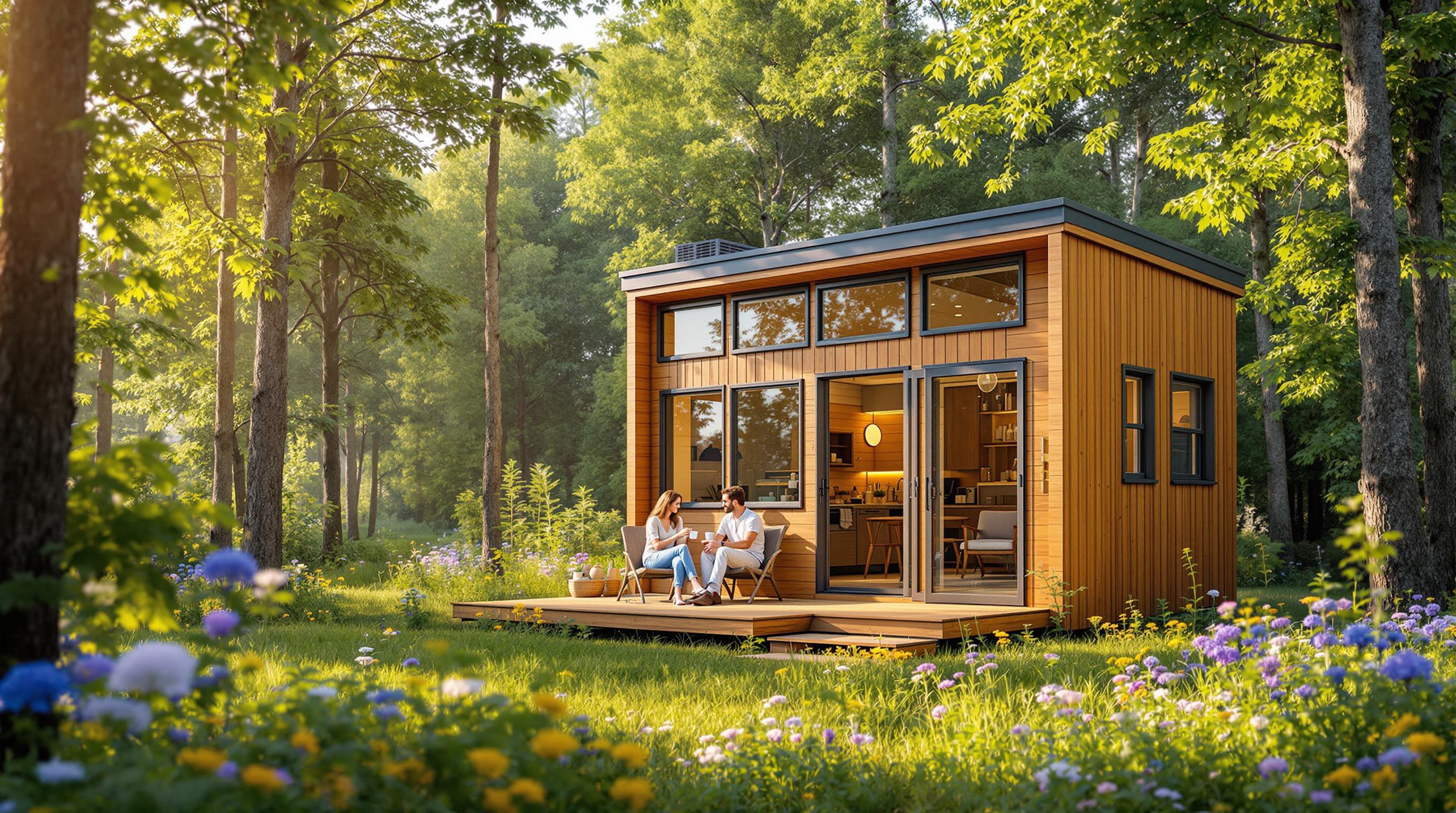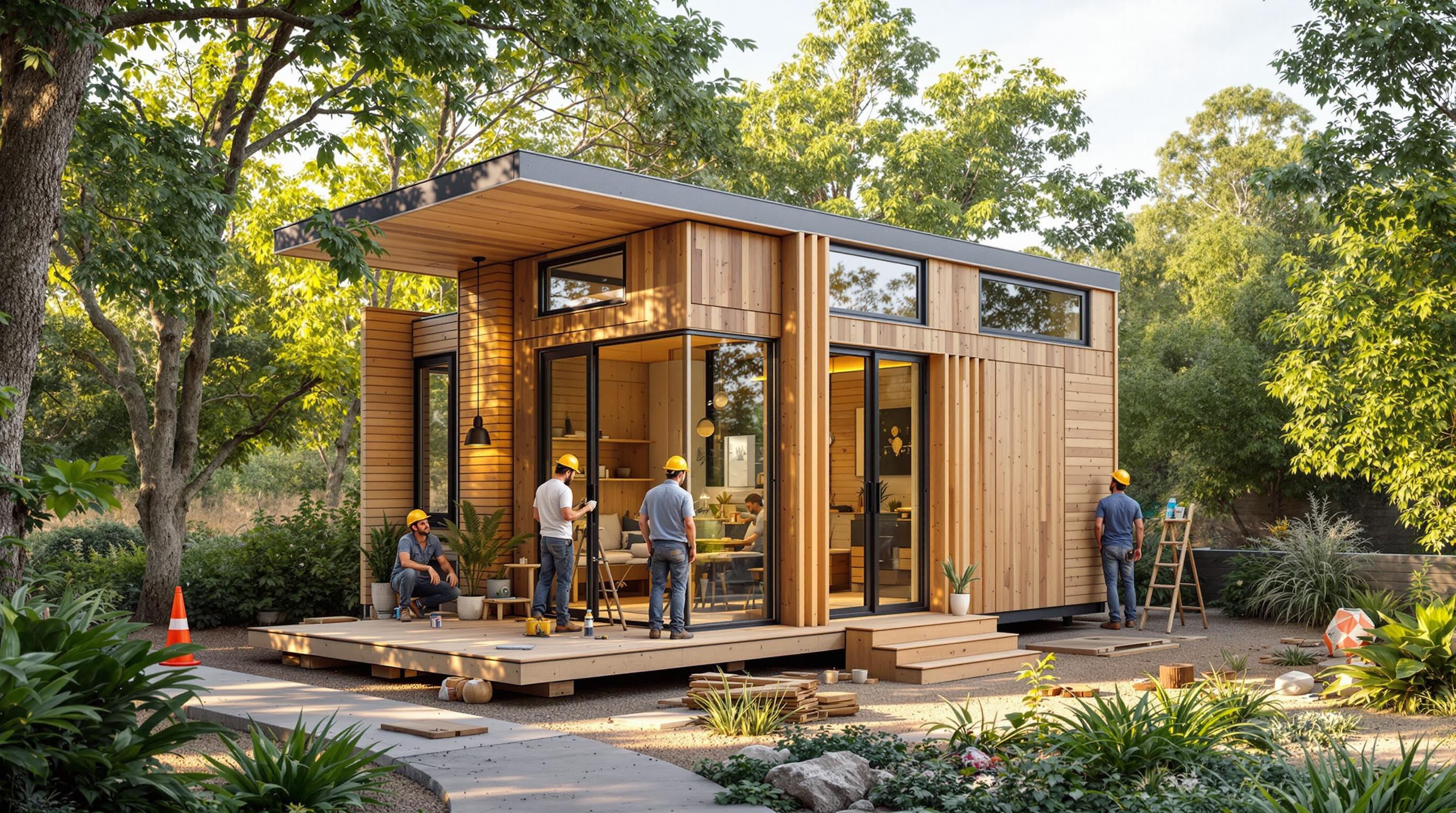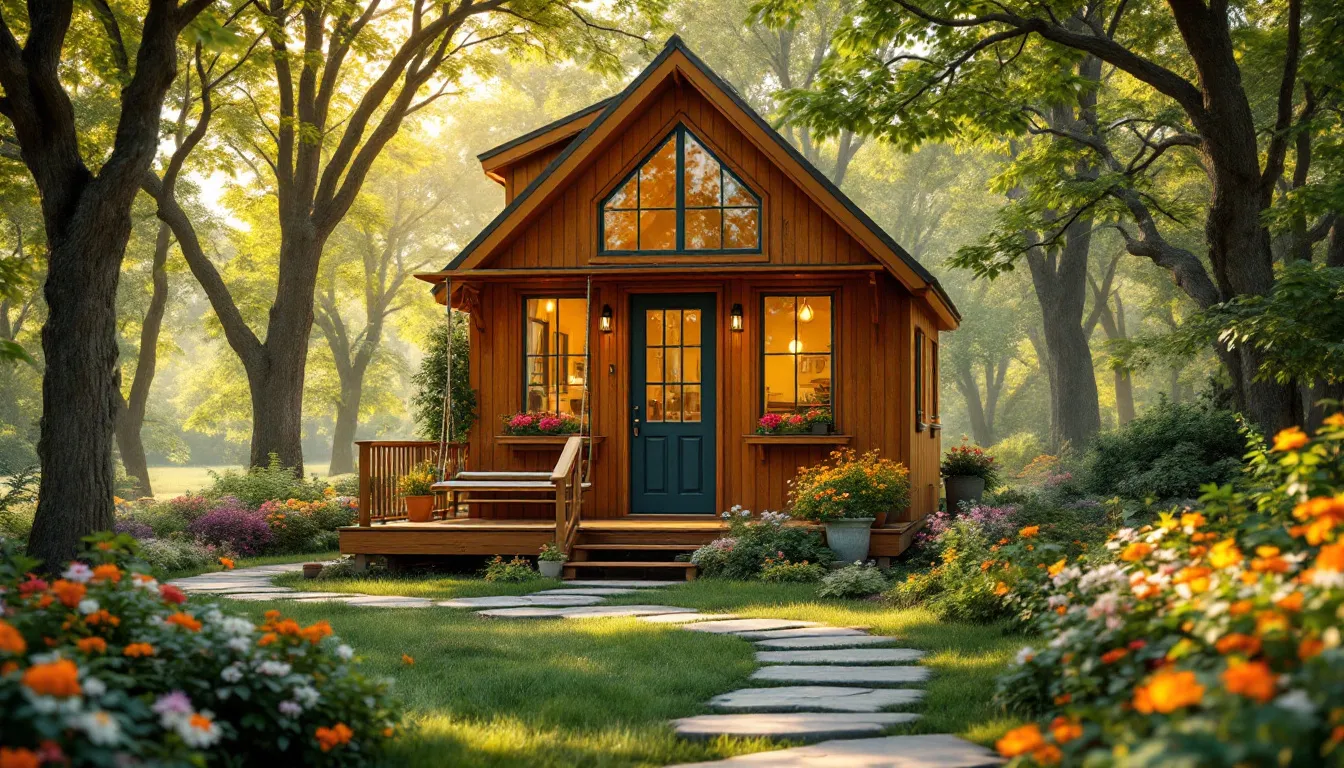Inverters are essential for tiny house solar systems because they convert DC power from solar panels into AC power, which household appliances need. Here's what you need to know:
-
Types of Inverters:
- Pure Sine Wave: Best for sensitive electronics like laptops and TVs.
- Modified Sine Wave: Suitable for basic appliances like lights and power tools.
- Hybrid: Ideal for systems combining solar, battery, and grid power.
- Quick Comparison:
| Inverter Type | Cost | Efficiency | Best Use Case |
|---|---|---|---|
| Pure Sine Wave | Medium to High | High | Sensitive electronics |
| Modified Sine Wave | Low | Moderate | Basic appliances |
| Hybrid | Medium to High | High with storage | Off-grid or mixed power systems |
-
Key Features to Consider:
- Pure sine wave output for stable power.
- Monitoring capabilities for energy tracking.
- Proper sizing to match energy needs.
-
Installation Tips:
- Ensure proper ventilation and follow wiring guidelines.
- Regular maintenance like cleaning and inspections extends lifespan.
Inverters are vital for efficient energy use in tiny houses, and choosing the right one depends on your energy needs, budget, and system type. Read on for detailed guidance on selection, installation, and troubleshooting.
Different Types of Inverters for Tiny Houses
String Inverters: Budget-Friendly Choice
String inverters are a practical option for tiny house solar systems, especially for those on a tighter budget. They connect multiple solar panels in a series, making them the most cost-effective solution for basic setups [3].
Their main advantage lies in simplicity: a single unit manages power conversion for all connected panels. This design makes installation easier, takes up less space, and reduces the number of components needed. However, there's a drawback - if one panel is shaded or underperforming, it can impact the entire system's efficiency [3].
Microinverters: Maximizing Panel Output
Microinverters are a smart choice for tiny houses with tricky roof designs or shading issues. Unlike string inverters, microinverters are mounted directly on each solar panel, converting DC to AC power individually [3].
This setup ensures each panel operates independently, which is great for maximizing energy production even if some panels are partially shaded or facing different directions. For tiny homes with limited roof space, this can make a big difference. While they cost more upfront, microinverters can boost overall system efficiency by as much as 25% in certain situations [3].
Hybrid Inverters: Solar and Storage Combined
Hybrid inverters are gaining traction among tiny house owners, particularly those looking to pair solar power with battery storage. These inverters combine traditional power conversion with the ability to manage battery systems, creating a more flexible energy solution [3].
| Feature | String Inverters | Microinverters | Hybrid Inverters |
|---|---|---|---|
| Cost | Lowest upfront cost | Higher initial cost | Mid to high range |
| Efficiency | Good in full sun | Excellent in all conditions | Good with battery backup |
| Installation | Simple and centralized | Distributed, more complex | Moderate complexity |
| Best Use Case | Basic setups | Shaded or complex roofs | Off-grid systems |
| Space Required | Minimal | None in living space | Moderate |
Hybrid inverters stand out for their ability to switch seamlessly between solar, battery, and grid power. With features like smart monitoring and energy storage, they help tiny house owners manage power efficiently and ensure a steady energy supply [1][2].
Now that you know about the inverter options, let’s dive into how to pick the right one for your tiny house solar system.
Offgrid Solar Inverter Buyer's Guide for Beginners
How to Pick the Right Inverter
Selecting the right inverter comes down to understanding your energy requirements, ensuring system compatibility, and sticking to your budget. Here's a breakdown to guide your decision.
How to Size Your Inverter
Getting the right size inverter is crucial for smooth operation. Start by calculating the total wattage of appliances you'll use at the same time. For example, if your inverter is 90% efficient, its capacity should be at least 10% higher than your total wattage [3].
Make sure the inverter's capacity matches your solar array, can handle peak energy demands, and leaves room for any future upgrades. Proper sizing keeps your tiny house solar system running efficiently, even during high energy use.
Important Features to Consider
Certain features can make a big difference in how well your system performs. Pay attention to these:
| Feature | Why It Matters |
|---|---|
| Pure Sine Wave Output | Ensures compatibility with sensitive electronics |
| Efficiency Rating | Impacts overall energy output |
| Monitoring Capabilities | Lets you track and optimize system performance |
| Warranty Coverage | Offers peace of mind, typically 10-25 years |
Pure sine wave inverters are especially useful for protecting sensitive devices by providing clean, stable power [3]. Monitoring tools can help you keep tabs on energy usage and fine-tune performance - important for tiny house setups.
Balancing Cost and Performance
"Investing in a quality inverter saves money long-term through improved efficiency and durability" [3].
When comparing costs, keep these factors in mind:
- Warranty Length: Longer warranties often reflect higher quality and manufacturer confidence.
- Efficiency Ratings: Better efficiency means more usable energy from your solar panels.
- Installation Costs: Some inverters require more complex (and costly) setups.
- Maintenance Needs: Think about long-term upkeep and how easy it will be to service.
While higher-end inverters come with a bigger upfront price tag, they often deliver better performance, last longer, and come with solid warranties.
Next, we’ll dive into how to install and maintain your inverter to keep it running smoothly for years to come.
sbb-itb-2ef3f3a
Installing and Maintaining Your Inverter
Steps for Proper Installation
Installing an inverter correctly starts with picking the right location. Look for a spot that’s well-ventilated and protected, leaving at least 6 inches of space around it for airflow [1]. In small spaces like tiny homes, utility closets or dedicated electrical compartments are good options.
Here’s the recommended wiring sequence:
- Connect solar panels to the charge controller.
- Wire the charge controller to the batteries (if used).
- Link the batteries to the inverter.
- Finally, connect the inverter to the AC panel.
Always stick to the manufacturer’s instructions and follow local electrical codes to ensure safety and proper operation.
Maintenance Tips for Long-Term Use
Keeping your inverter in good shape requires regular upkeep. Routine maintenance not only extends its life but also helps it run efficiently.
| Maintenance Task | How Often | What to Do |
|---|---|---|
| Regular Checks | Weekly/Monthly | Inspect connections, monitor output, and check for error codes. |
| Cleaning | Every 3 Months | Clear dust buildup and ensure airflow isn’t blocked. |
| Professional Inspection | Once a Year | Have a technician perform a full system check. |
Be alert for signs that your inverter might need attention, such as:
- Strange noises during operation
- Reduced power output
- Error messages on the display
- Overheating
For those using microinverter systems, maintenance is often simpler since each unit works independently. However, it’s still important to check connections periodically [4].
If you’re in a dusty or extreme environment, you may need to clean your inverter more often. Always stick to cleaning materials recommended by the manufacturer to avoid damaging the system [5].
How Inverters Fit Into Tiny House Solar Systems
How Inverters Work with Other Components
Inverters play a crucial role in tiny house solar systems by converting DC power from solar panels into AC electricity that powers household appliances. They work alongside other components to keep the system running smoothly. The exact setup depends on whether the system is off-grid, grid-tied, or hybrid [1][3].
A standard setup might include solar panels connected to a pure sine wave inverter, which ensures efficient power conversion and stable performance. Here's how inverters interact with key components:
- Solar Panels: Transform their DC power output into AC electricity.
- Charge Controllers: Regulate power flow to prevent overcharging.
- Batteries: Store surplus energy for future use.
- AC Panel: Distributes the converted electricity to appliances.
Hybrid inverters are increasingly popular because they allow for smooth transitions between solar, battery, and grid power, ensuring a steady energy supply [3][6].
Comparing Off-Grid and Grid-Tie Systems
Deciding between off-grid, grid-tied, or hybrid systems depends on factors like location, energy needs, and resources. Here's a breakdown of how inverters function in each type:
| System Type | Inverter Role | Ideal For |
|---|---|---|
| Off-Grid | Operates independently using battery power | Remote areas, complete energy self-sufficiency |
| Grid-Tie | Syncs with the utility grid and exports excess power | Locations with dependable grid access |
| Hybrid | Manages power from multiple sources | Flexible setups requiring adaptability |
Off-grid systems often use pure sine wave inverters to protect sensitive electronics. Grid-tied systems need inverters capable of matching the grid's frequency and voltage [3][6].
To avoid power bottlenecks, make sure your inverter's capacity aligns with the size of your solar array. Many modern inverters also include monitoring features, letting you track system performance and make tweaks as needed.
Common Problems and How to Fix Them
Dealing with Space Constraints
Installing inverters in tiny houses often comes with the challenge of limited space. The trick is to make the most of the available room without sacrificing performance.
Some practical options include wall mounting to improve airflow, using external enclosures to avoid overheating, and opting for compact systems with built-in storage. Specialized mounting hardware can also help with efficient installation while ensuring proper ventilation [3].
While space issues can be handled with smart planning, other inverter problems require targeted troubleshooting.
Fixing Common Inverter Problems
Inverter problems can usually be resolved with a step-by-step approach. Below are the most common issues and how to address them:
Power Fluctuations
Check that the input voltage range of your inverter matches your solar panel's output. If you notice unstable power, inspect for loose connections or damaged wiring. Many modern inverters come with built-in diagnostic tools to help identify these fluctuations [3][6].
System Shutdowns
Frequent shutdowns might be due to overheating, overloading, low battery voltage, or faulty connections. Regular maintenance and ensuring your system is properly sized can help avoid these problems [3][6].
Compatibility Issues
When adding new components, confirm that your inverter's specifications align with the rest of the system. For example, the input voltage range should match your solar panel output, and the battery must be compatible with the inverter's charging capabilities [7].
"Regular monitoring prevents major issues. Keep records of performance to identify problems early."
For more complex issues, consulting a solar expert can save both time and money. Many manufacturers also provide remote diagnostic services, which help tiny house owners troubleshoot without needing an on-site visit [6].
Final Thoughts and Helpful Resources
Key Takeaways from This Guide
Picking the right inverter plays a big role in the success of your tiny house solar setup. Microinverters, like the Enphase IQ7, Chilicon Power Micro, and AP Systems YC500A, are known for their long lifespans - often matching the 25-year durability of modern PV modules [4].
When evaluating inverters, keep these factors in mind:
| Feature | Why It Matters |
|---|---|
| Panel-Level Monitoring | Helps spot underperforming panels and improve overall system efficiency. |
| Shade Tolerance | Directly impacts how efficiently your system operates in less-than-ideal conditions. |
| Installation Space | Affects where and how your inverter can be mounted. |
| Warranty Coverage | Provides peace of mind, with many warranties ranging from 10 to 25 years. |
If you're eager to learn more about designing and implementing solar systems for tiny houses, there are plenty of resources available to guide you.
Explore More at Tiny Houses For Sale, Rent, and More
Beyond choosing the right inverter, finding a solar-ready tiny house or working with skilled builders can make the process much easier. TinyHouseSearch.com is a great place to start. It features listings for solar-ready tiny homes and connects you with builders who specialize in energy-efficient designs.
The website also includes a directory of contractors, community resources, and advice on zoning regulations specific to solar setups. This takes some of the guesswork out of the technical and legal challenges.
A well-chosen inverter, paired with regular maintenance, is key to building a dependable solar system for your tiny house.



